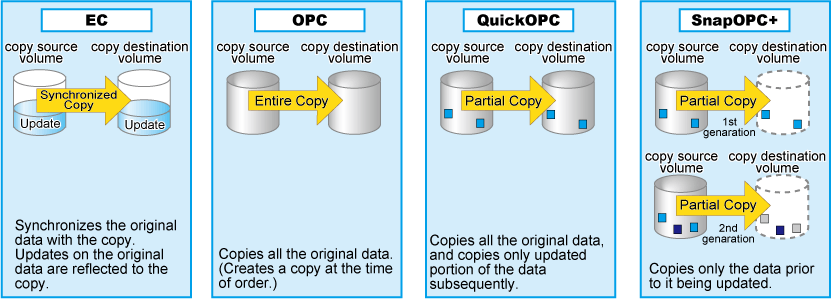The Advanced Copy functions allow the Disk storage system to carry out high-speed copying operations itself, with no need to draw on server CPU resources. With Advanced Copy functions, at any point in time a business data volume can be copied to a separate copy volume, quickly and within the Disk storage system. Once the copy is complete, the copy volume can be separated from the business volume ensuring no further updates to the business volume are applied to the copy volume. This allows the copy volume data to be backed up to a tape device, as a point in time copy of the business data, while normal operations continue.
Advanced Copy methods
Advanced Copy functions provide three clone functions (EC, OPC, QuickOPC) and one snapshot function (SnapOPC+).
Clone is a full (real) copy of the original data.
Snapshot is a virtual copy of the original data.
A function that always creates a synchronized copy of a business data volume on a copy volume (Mirroring method).
The business volume and copy volume are synchronized but can be separated at any required time (mirror suspend). The copy volume can then be backed up to a tape device while business operations continue on the business volume.
Suspend/Resume functions can be used to re-establish the mirror by copying only updated data since the mirror was suspended.
A function that creates a copy of the business data volume at any point in time (Background Copy).
Data on the business volume is copied logically to a copy volume, quickly, as and when required.
The copy volume can be used for backup operation, to a tape device, without waiting for physical copy completion, while business operations can continue on the business volume.
A function that creates a copy of all the business data volume and subsequently only copies updated data (Background Copy). This suits large database operation where backup times must be reduced.
A function that creates a copy of the data prior to it being updated (Copy-on-Write).
As requires less copy volume capacity compared with clone, SnapOPC+ is ideal for copy operations for systems with relatively few updates such as file servers.

These copy methods all copy the data as it exists at a specific point in time, but there are different features, advantages and disadvantages to each method as detailed below:
Copy type | Clone | Snapshot | ||
|---|---|---|---|---|
Function name | EC | OPC | QuickOPC | SnapOPC+ |
Copy method | Mirror breaking method | Background copy method | Background copy method | Copy-on-write method |
Timing of actual copy load | Before "mirror breaking" | After the copy command is issued | After the copy command is issued | - |
Effect on access to the copy source while copy is running | N/A | Minor | Minor | Yes |
Effect on access to the copy source after copy has "finished" | N/A | Slight during background copy | Slight during background copy | Yes |
Lifetime of copy session | Until the Equivalent state is stopped | Until background copy is completed | Until session is stopped and copy is completed | Until session is stopped |
Size of copy destination area | Same as the copy source | Same as the copy source | Same as the copy source | Sufficient for changed areas |
Copy action during restore |
| If OPC is active, copy back only the already copied data | Copy back only the already copied data | Restore operation is not available (use OS tools to copy whole files instead) |
Best used for... |
|
|
|
|
Note
These are generic observations based on the mechanisms involved. Actual effect on servers will depend on the specifics of the usage environment.